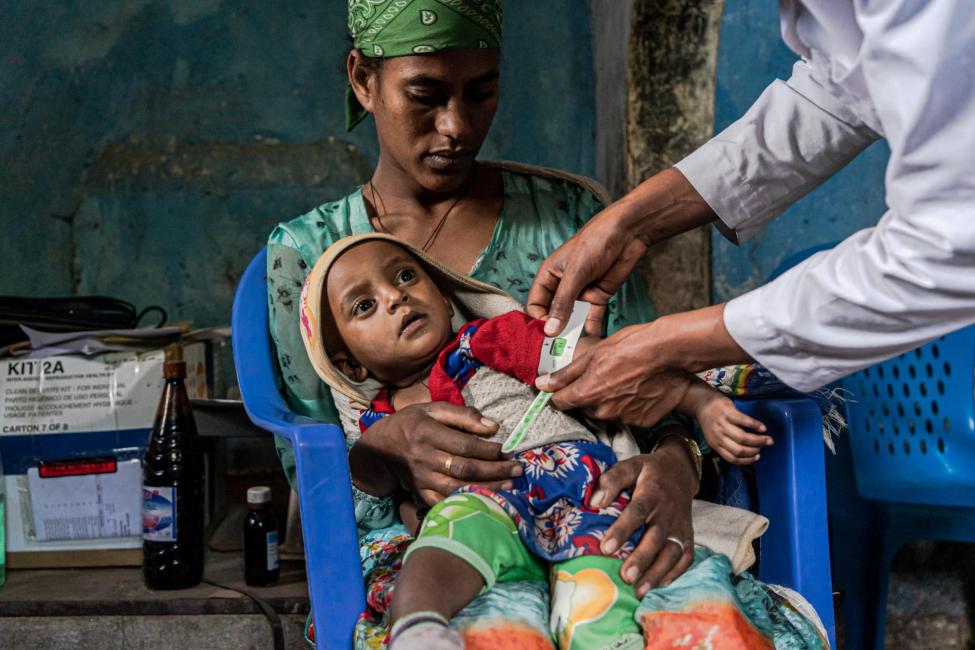-
Who We Are
WHO WE AREThe International Organization for Migration (IOM) is part of the United Nations System as the leading inter-governmental organization promoting humane and orderly migration for the benefit of all. IOM has had a presence in Ethiopia since 1995.
About
About
IOM Global
IOM Global
-
Our WORK
Our WorkAs the leading inter-governmental organization promoting since 1951 humane and orderly migration, IOM plays a key role to support the achievement of the 2030 Agenda through different areas of intervention that connect both humanitarian assistance and sustainable development. Across Ethiopia IOM has been contributing to the efforts of the Government to effectively manage migration through a wide variety of projects and programmes.
Cross-cutting (Global)
Cross-cutting (Global)
- Data and Resources
- Take Action
- 2030 Agenda
Gondar, Ethiopia – “When we arrived at this site, we were severely dehydrated, and my child was not well. The health team here had to treat him for some time before he could feel better,” says 26-year-old Yewubnesh Mihrete. This young mother is among over 2,000 Internally Displaced Persons (IDPs), or approximately 700 households, living at Dabat site in Gondar, northern Ethiopia.
Fleeing the conflict in Tigray, Yewubnesh arrived at Dabat IDP site and was provided with vital food and non-food items, and shelter by the International Organization for Migration (IOM), the National Disaster Risk Management Reduction Commission and other humanitarian partners.
Yewubnesh was particularly grateful for the medical care provided to her child. “If this service was not given to me and my son, I would have been forced to beg for help,” she says.
The kindness of the host community is something she is also thankful for. However, medical care is not something she could have received from the community, who themselves had very limited access to health services before the mobile health post at Dabat camp was established.
When conflict broke out, the young mother was faced with two bleak options – either stay in the conflict area, or flee to a place she had never been to, banking on the kindness of strangers. Yewubnesh chose the latter and says migrating with little food and water while her child was only six months old was one of the toughest decisions she had to make.
“When the conflict erupted, we escaped and sought safety with nothing but the clothes on our backs. We did not have any food or water. I had neither protection for my son, nor the proper supplementary food he needed. It was very difficult,” she says, recalling the situation when she first arrived at Dabat, in the north of Amhara region.
Today, this mother is happy that her two-year-old has recovered from his severe malnutrition and is doing much better. “He is two years old now and he is doing great, thanks to God and the IOM medical team who helped me with the treatment here. They saved my child’s life.”
Before the conflict erupted, Yewubnesh owned a small shop in her hometown in Tigray, selling vegetables and grocery items. However, when the conflict began, she and her husband became separated, and she had to walk for a long distance with her child on her back in search of safety.
When the number of displaced people in Ethiopia increased over the past few years due to several factors, the number of women needing support also increased. Despite their limited involvement in conflict and other man-made disasters, women like Yewubnesh, and children, are disproportionately the major victims.
In response to the impact of the conflict, IOM has helped set up 61 displacement sites in northern Ethiopia alone, with 49% of the displaced being women.
IOM also provides family planning and maternal health care for women, and other health care services for adults and children hosted at Dabat and other displacement sites. “Providing this healthcare minimizes maternal deaths,” says Selamawit Yalew, IOM’s Mobile Health Nutrition specialist and midwife at Azezo Gondar.
The establishment of health care clinics at displacement sites is creating easy access for the community since health facilities are at times located in distant areas. “We work with the government health bureau here and we have managed to make health services accessible to the community,” says Selamawit, explaining how the partnership has facilitated the formation of health clinics at the Central Gondar Zone Azezo-Kulich Meda site.
“Whenever IDP sites are set up we consider the most vulnerable groups who might need health support,” adds Gilbert Ngetich, Head of Gondar Sub-Office for IOM Ethiopia. “We have deployed medical staff to respond to the health needs of the community and have also set up three mobile health clinics at three IDP sites in Gondar,” he says.
IOM reached over 1.4 million individuals through direct health support in Ethiopia in 2021 alone. IOM’s health support in the Central Gondar Zone was made possible through funding support from the Centers for Disease Control and Prevention (CDC), Ethiopia Humanitarian Fund (EHF) and the German Federal Foreign Office (GFFO).
For more information contact Alemayehu Seifeselassie, IOM Ethiopia, aseifeselassie@iom.int.


